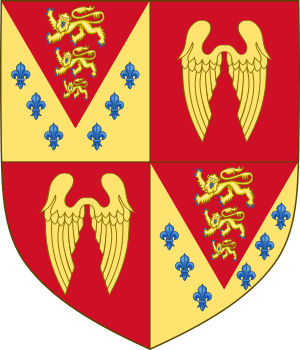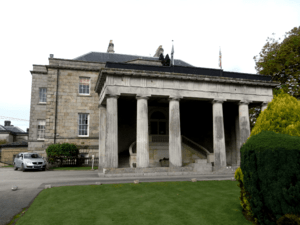Edward St Maur, 11th Duke of Somerset facts for kids
Edward St Maur, 11th Duke of Somerset (born Seymour; 24 February 1775 – 15 August 1855) was an important British noble. He was known as Lord Seymour until 1793. He owned large estates in Wiltshire and Devon. The Duke was also a very talented mathematician and had an interest in astrology.
Life and Achievements
Edward St Maur was born in Monkton Farleigh, Wiltshire. His father was Webb Seymour, the 10th Duke of Somerset. Edward was baptised as Edward Seymour. Later in his life, he changed his name to Edward St Maur. He believed this was the older, original spelling of his family's name.
In 1793, when his father passed away, Edward became the 11th Duke of Somerset. In 1795, he went on a long trip around England, Wales, and Scotland. He wrote about his journey in a journal, which was published later. His travels took him to faraway places like the Isles of Staffa and Iona.
The Duke was very good at mathematics. He led several important scientific groups. He was the president of the Linnean Society of London from 1834 to 1837. He also served as president of the Royal Institution from 1826 to 1842. He was a member of the Royal Society, a famous group for scientists.
In 1820, he was chosen to be the first president of the Astronomical Society of London. This society was created for people who study stars and space. However, a friend named Joseph Banks convinced him to step down. Banks thought there shouldn't be a separate society just for astronomy. In 1837, Queen Victoria made him a Knight of the Garter. This is a very special award. He also supported the Free Church of England.
Homes and Estates
In 1808, the Duke bought a large house in London on Park Lane. He called it Somerset House. He spent a lot of his time there.
In 1829, he bought the Stover estate in Devon. This included Stover House, which became his main home. He brought a valuable art collection to Stover House. This collection, called the "Hamilton" collection, included paintings by famous artists like Rubens and Reynolds. The Stover estate also came with the Stover Canal and the Haytor quarries. The Duke added a large, grand entrance to Stover House. He also built a matching lodge at the entrance.
Family Life
The Duke of Somerset was married twice. His first marriage was on 24 June 1800 to Lady Charlotte Douglas-Hamilton. She was the daughter of the 9th Duke of Hamilton. They had seven children together:
- Edward Seymour, 12th Duke of Somerset (1804–1885), his oldest son. He inherited Stover House.
- Archibald St Maur, 13th Duke of Somerset (1810–1891), his second son. He became the Duke after his older brother passed away without children. He inherited Maiden Bradley House.
- Algernon St. Maur, 14th Duke of Somerset (1813–1894)
- Lady Charlotte Jane Seymour (1803–1889)
- Lady Jane Wilhelmina Seymour
- Lady Anna Maria Jane Seymour (d. 1873)
- Lady Henrietta Seymour
After his first wife passed away in 1827, he married Margaret Shaw-Stewart on 28 July 1836. She was the daughter of Sir Michael Shaw-Stewart. They did not have any children.
Later Years
Edward St Maur, 11th Duke of Somerset, passed away at his London home, Somerset House, in August 1855. He was 80 years old. He was buried at Kensal Green Cemetery in London. His second wife, Margaret, passed away in 1880 and was buried with him.



